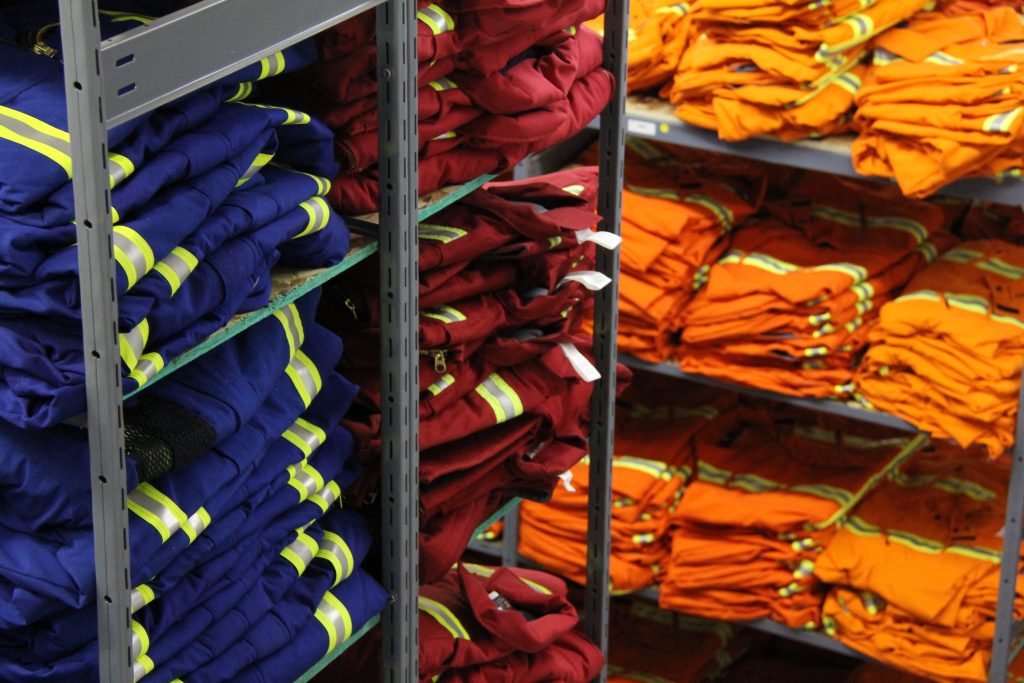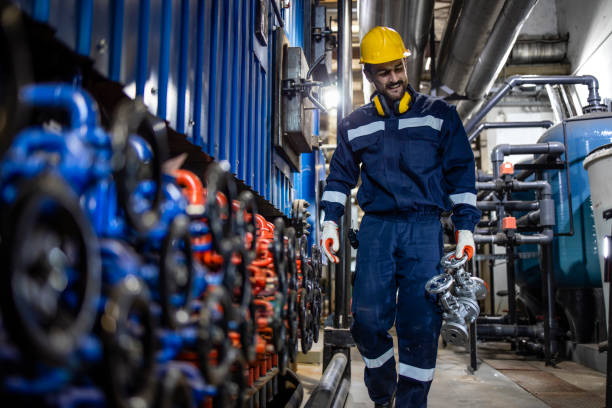1. Why Fabric Matters in Workwear
The fabric is the foundation of the garment. It determines how well your clothes will perform in tough conditions. The right fabric will keep you safe, comfortable, and allow you to move freely, while also extending the lifespan of your workwear. If you’re in a high-risk environment with heat, chemicals, or heavy machinery, you need fabric that provides specific protections. If you’re in a less risky environment, you may prioritize comfort and durability. Understanding the role of fabric is the first step to choosing the right workwear.
You need to choose the right fabric for your work clothes because it affects how safe you are, how comfortable you are, and how long your clothes last. Good fabrics will protect you from the environment and last a long time. They will also let you move around, which is important in many industries.
2. What to Consider When Choosing Workwear Fabrics
When choosing workwear fabrics, consider the following factors to ensure your clothes will meet your needs:
- Safety: Depending on your industry, you may need workwear that protects you from fire, chemicals, or electrical hazards. You’ll need fire-retardant, acid-resistant, or anti-static fabrics in these cases.
- Comfort: You’re going to be wearing this stuff for a long time, so you need to be comfortable. Choose fabrics that breathe, feel nice against your skin, and allow for easy movement.
- Durability: Your fabric needs to stand up to the work environment. This means it shouldn’t wear out, change color, or shrink after a few washes. It should last a long time.
- Special Functions: Some fabrics have additional features such as being waterproof, stain-resistant, or having UV protection. These are useful for specific job requirements.
3. Common Workwear Fabrics
Choosing the right fabric is key to ensuring your workwear is comfortable, durable, and fit for the job. Here’s a closer look at some of the most common fabrics used in workwear:
3.1 Cotton Fabric
Cotton is a natural fiber that’s comfortable and breathable. It’s soft against your skin and lets air circulate, so it’s great for hot, humid conditions. In Australia, cotton fabrics are popular for workwear. For example, 150gsm cotton is used for summer work shirts, while 190gsm and 240gsm twills are used for heavier-duty garments like trousers. The 310gsm cotton is used for more durable work trousers that need to be comfortable but also tough enough for the job. People who wear workwear all day often prefer cotton because it’s breathable and soft, which helps keep them cool and comfortable.
3.2 Polyester/Cotton Blends
Polyester/cotton blends are the most common fabrics used in workwear. They come in a wide range of weights (100gsm to 350gsm) and weaves (poplin, twill, drill, canvas, ripstop). People like this blend because it combines the comfort and breathability of cotton with the strength and durability of polyester. Whether you work in construction, logistics, or general industrial jobs, you’ll find that polyester/cotton fabrics are versatile and practical. They don’t shrink, wrinkle, or fade, even after many washes, so they’re great for workwear that needs to last. That’s why you’ll find polyester/cotton blends in industries where you need workwear that’s both comfortable and durable.
3.3 Nylon/Cotton Blends
Nylon is incredibly strong and resistant to abrasion. When you blend it with cotton, you get a fabric that’s tough but comfortable. This blend is great for workwear that needs to be durable but still comfortable to wear. People choose nylon/cotton blends for protective gear and uniforms in industries like heavy manufacturing and outdoor work, where you need workwear that can handle tough conditions. For example, the military uses nylon/cotton fabrics for uniforms because they can take a beating but are still comfortable to wear. This blend is tough (because of the nylon) but comfortable (because of the cotton), so it’s perfect for demanding environments
3.4 Polyester/Viscose Blends
Viscose (also called rayon) feels smooth and silky and drapes well. When you blend it with polyester, you get a fabric that’s soft, doesn’t wrinkle, and is durable enough for workwear. People like this blend for corporate uniforms and other situations where you need workwear that looks good as well as performs. If you need workwear that looks professional and polished, you’ll want to consider polyester/viscose blends. They look nice and are great for situations where you want to make a good impression, but you still need workwear that will hold up.
3.5 Functional Fabrics
Functional fabrics are designed for specific environments:
- Flame-retardant fabrics: These are necessary in environments where there is a fire risk, such as oil and gas, welding, or electrical work.Flame-retardant fabrics are treated to resist ignition and slow the spread of flames, providing crucial protection for workers.
- Acid-resistant fabrics:These fabrics are designed to withstand exposure to harsh chemicals, making them essential in laboratories,chemical plants, and any environment where workers might encounter hazardous substances.
- Waterproof, stain-resistant, and anti-viral fabrics:These are ideal for industries like healthcare, food processing, and chemical manufacturing. They protect workers by repelling liquids and stains and sometimes even offering antimicrobial properties
- Anti-mosquito and UV-protective fabrics:These fabrics are perfect for outdoor work, providing protection from insect bites and harmful UV rays. This is critical in environments with significant sun exposure or where diseases like malaria are a concern.
- Anti-bacterial, chlorine-resistant, and moisture-wicking fabrics: These fabrics are used in active workwear and help maintain hygiene and comfort. They’re particularly valuable in high-sweat or wet environments, as they resist bacteria, chlorine damage, and wick moisture away from the body.
- Wrinkle-free fabrics:For industries where a neat appearance is important, wrinkle-free fabrics are a lifesaver. These fabrics maintain a smooth, polished look, even after a full day of work.
4. New High-End Workwear Fabrics

As technology evolves and environmental concerns grow, so do the materials used in workwear. Here’s a look at some of the latest innovations in high-end workwear fabrics:
- PFC-free waterproof fabrics:Traditional waterproof fabrics often rely on perfluorinated chemicals (PFCs) to repel water. However, PFCs are harmful to the environment. This has led to the development of PFC-free alternatives. These new waterproof fabrics offer the same level of protection without the environmental impact, making them an excellent choice for eco-conscious industries.
- Recycled polyester:With sustainability becoming increasingly important, recycled polyester has become a popular choice in workwear. Made from post-consumer waste, such as plastic bottles,recycled polyester provides the durability and performance of virgin polyester while reducing environmental impact. It’s a win-win for businesses looking to reduce their carbon footprint without compromising on quality. Learn more about sustainabile textile. https://ripstopfabric.com/recycled-polyester-journey-from-bottle-to-fabric/
- Organic cotton:Organic cotton is grown without synthetic pesticides and fertilizers, making it a more sustainable option. It’s also gentler on the skin, as it’s free from chemical residues that can cause irritation. As consumers and businesses alike become more environmentally conscious, organic cotton is becoming a preferred choice for workwear, especially in industries that prioritize sustainability.
- Polycotton stretch fabric: This innovative fabric combines the durability of polycotton with the flexibility of elastane, creating a material that’s both tough and comfortable. It’s perfect for jobs that require a lot of movement, as the fabric stretches with you, reducing restrictions and improving overall comfort. Learn more.
- Ripstop Fabric:Ripstop fabric is woven with a special reinforcing technique that makes it resistant to tearing and ripping. This fabric is known for its distinctive crosshatch pattern, which not only adds strength but also gives it a unique look. It’s particularly useful in rugged environments where workwear needs to stand up to heavy use and potential damage. Learn more.
- Industrial Laundry-Resistant Fabrics:Workwear in industries like healthcare and hospitality often requires frequent washing at high temperatures, which can wear down fabrics over time. Industrial laundry-resistant fabrics are designed to withstand these harsh conditions, maintaining their integrity, color, and shape even after numerous wash cycles. This makes them ideal for uniforms that need to be clean, durable, and professional-looking every day. Learn more.
5. How to Test the Quality of Workwear Fabrics
Testing the quality of workwear fabrics is important to ensure they’re up to the job. Here are some key tests and their corresponding ISO standards:
- Tensile strength (ISO 13934-1):This measures how much force it takes to pull the fabric apart. It tells you how durable the fabric is when it’s under stress.
- Tear strength (ISO 13937-1):This measures how much force it takes to tear the fabric. It’s important for workwear that’s going to get treated rough.
- Pilling resistance (ISO 12945-2):This measures how likely the fabric is to form little balls of fiber on the surface. You want a fabric that’s not going to do that because it looks bad and it’s going to wear out faster.
- Shrinkage (ISO 5077): Measures how much the fabric shrinks after washing.
- Colorfastness (ISO 105 series): Evaluates how well the fabric retains its color under various conditions, for example, washing, light, rubbing, hot press etc.
- Formaldehyde content (ISO 14184-1): Ensures the fabric has safe levels of formaldehyde, a known carcinogen.
- pH value (ISO 3071): Assesses whether the fabric’s pH is balanced to prevent skin irritation.
- Fabric grading systems: To evaluate the overall quality of fabric, the American Four-Point System is widely used. This system assigns points for defects based on their size and severity, helping manufacturers and buyers evaluate the fabric’s quality before it’s made into workwear.
By doing these tests, manufacturers can make sure their workwear fabrics are not only durable and comfortable but also safe for the people who wear them.
6. How to Upgrade Your Existing Workwear
If you want to upgrade your workwear, start with the fabric.
Look at what you’re using now and ask yourself if it’s working for you. Is it durable enough? Is it comfortable enough? Do you want something more sustainable? Talk to us now.
Find out what else is out there. You can upgrade to fabrics that have more functionality. They can wick moisture. They can be flame resistant. They can be ecofriendly.
The right fabric not only keeps you safe, but it also makes you more comfortable and lasts longer. It’s a critical part of your work environment. Whether you want more durability, more functionality, or more sustainability, upgrading your workwear fabric can make a big difference in how your workwear performs and how you feel about it.

